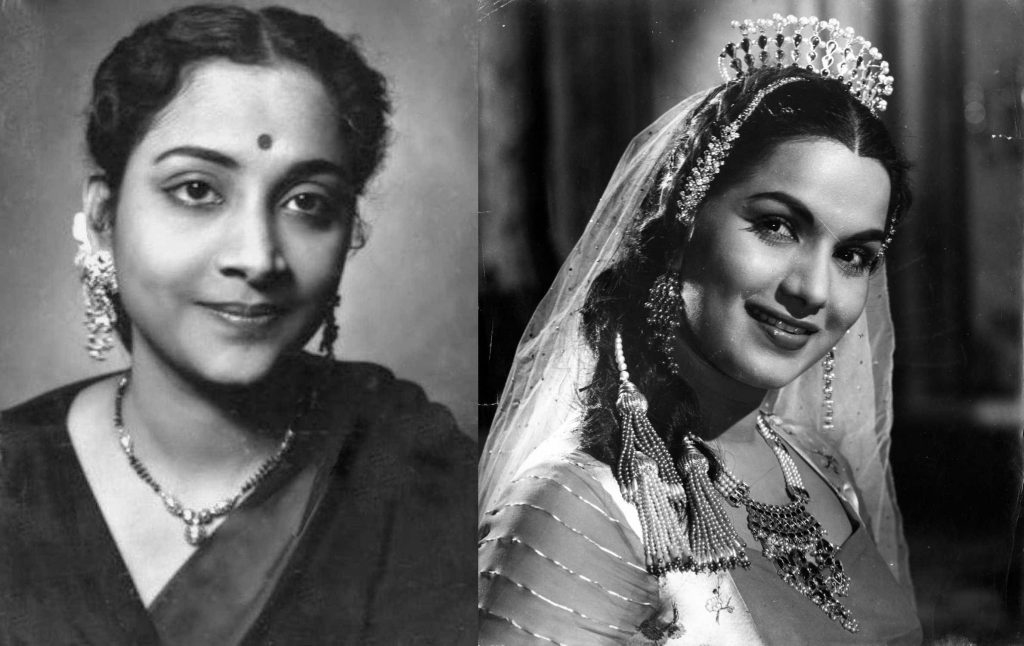Shyama was not only one of the busiest actresses of Hindi cinema of the 1950s but was also one of the most sparkling and liveliest performers on the Indian screen. It is little wonder then that Geeta Dutt’s effervescent singing suited her to a T. This combo has come up with some great songs in films like Dillagi (1949), Maa (1952), Aasmaan (1952), Shrimatiji (1952), Aar Paar (1954), Shart (1954), Musafir Khana (1955), Chhoo Mantar (1956), Bhai Bhai (1956), Chandan (1958), Apna Ghar (1960) and Duniya Jhukti Hai (1960). If Geeta Dutt’s singing and throw of words was unique, so was Shyama’s enactment of these songs. There was always something extra special when Shyama moved her lips to songs sung by Geeta Dutt and brought them to life on the silver screen.
An early song that got the combination going was in Dillagi when a rather young Shyama lip synced the second version of the film’s chart buster, Tu Mera Chand Main Teri Chandni. After the first two lines on actor Shyam, Shyama (and Geeta Dutt) take over the song. We have Shyama atop a swing blissfully singing away without realizing she has reminded heroine Suraiya about her tragically aborted romance with Shyam and the song they used to sing together in happier times. This was the first song that Geeta Dutt ever sang for music maestro Naushad and just one of two songs that she has sung for the master composer, the other being Mujhe Huzoor Tumse Pyar Hai, from Mehboob Khan’s ill-fated Son Of India (1962).
In Filmistan’s Shart, a loose take off from Hitchcock’s Strangers On a Train (1951), Geeta Dutt sang just one song for Shyama, playing the film’s leading lady, who is implicated in a murder she did not do and is blackmailed into committing one. In an album otherwise dominated by Lata Mangeshkar and Asha Bhosle’s vocals, composer Hemanta Mukherjee still gave Dutt THE most important female song in the film, the tandem number Na Yeh Chand Hoga, wherein he sang the male version himself. Dutt, who gives the song much depth and feeling, would include it among her career’s ten best when she came out with a compilation list in 1957. Incidentally, this song and the main refrain would also find its way into the Pakistani film, Sassi (1954), based on the Sassi-Punnu tragic love story. You can watch the Geeta Dutt version here.
Geeta Dutt and Shyama hit their peak with Guru Dutt’s crime thriller, Aar Paar. Shyama recalled in an interview that she was way too busy with other assignments when the offer to act in the film came from Guru Dutt. And that it was Geeta Dutt who specially came to her and requested her to do the role of Nikki, a garage owner’s daughter who falls for the hero. Not only is it one of her best films, but Aar Paar would also immortalize Shyama as the girl who could carry off dungarees like no one else. The Geeta Dutt-Shyama duo had three magical songs in the film but if one still has to choose one, it would have to be the make up song after a lover’s tiff when Shyama concedes that she was wrong and that they should forget their quarrel, Yeh Lo Main Hari Piya. Shot inside a taxi, and aided perfectly by Dutt’s lively vocals, Shyama wonderfully brings out the feelings of a young girl in the early stages of love.
Singers Mohammed Rafi and Geeta Dutt, composer OP Nayyar and lyricist Majrooh Sultanputi would combine for another wonderful reconciliation song, Achhaji Maaf Kar Do, in M Sadiq’s comedy Musafir Khana that starred Karan Dewan opposite Shyama. There is an easy camaraderie not just between Rafi and Dutt who play off each other beautifully, but even between Shyama and Dewan as they coo sweet nothings to each other.
By far the most memorable song of this twosome came in AVM’s social Bhai Bhai starring real life brothers Ashok Kumar and Kishore Kumar besides Nimmi, Nirupa Roy, Om Prakash and Shyama. In an album dominated by Lata Mangeshkar, this solitary Geeta Dutt song, Ae Dil Mujhe Bata De, filmed on Shyama, proved by far to be the most popular song in the film. Playing a negative character who breaks up Ashok Kumar’s marriage to Nirupa Roy, Shyama has arguably never looked or acted better as she entices Kumar through this song with Dutt’s seductive voice. In fact, when Lata Mangeshkar was not free to represent Madan Mohan at a function celebrating the silver jubilee of the Indian Talkie in 1956, he turned to Dutt to sing Ae Dil Mujhe Bata De for him. See the song here.
1957 was the big breakthrough year for Asha Bhosle and this period from the late 1950s onward saw Bhosle and Lata Mangeshkar mostly lending their voices for Shyama and other leading ladies of the time as Geeta Dutt began to slowly lose out to the Mangeshkar sisters. Yet, when she and Shyama reunited for the odd song as in Duniya Jhukti Hai (Gumsum Sa Yeh Jahan) or Apna Ghar (Tumse Hi Meri Zindagi), it only helped to reinforce what a special pair they were.



Sigh. Wish like dropping everything else, and watching all these films again.
Same here…
You have brought out the best in both Shyama and Geeta Dutt. In Shart Geeta Dutt had another song [ Chand ghatne laga , raat dhalne lagi ] , which of course is filmed on Shashikala. Good going Karan. Makes compulsive reading. Am sharing
Thanks!
Yes I do know of Chand Ghatne Laga in Shart. In fact it’s one of my favourite Geeta Dutt songs but in sticking to the topic, mentioned only the one filmed on Shyama.
Lata and Asha created a social construct that made them indispensable at the cost of others,like Geeta.